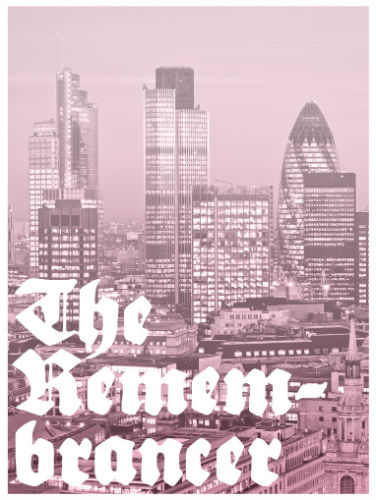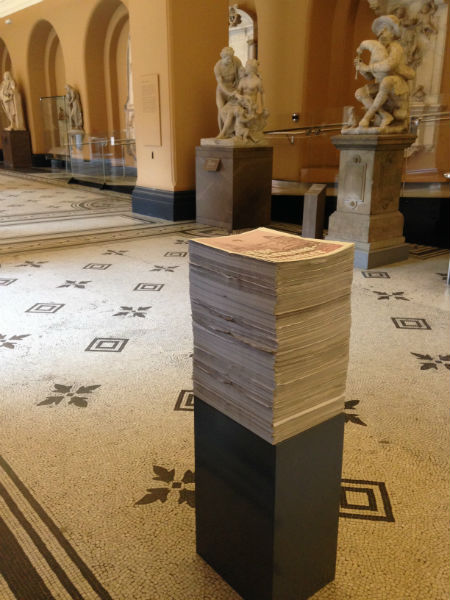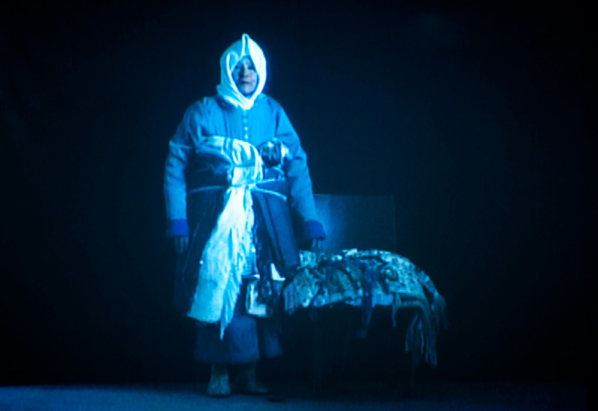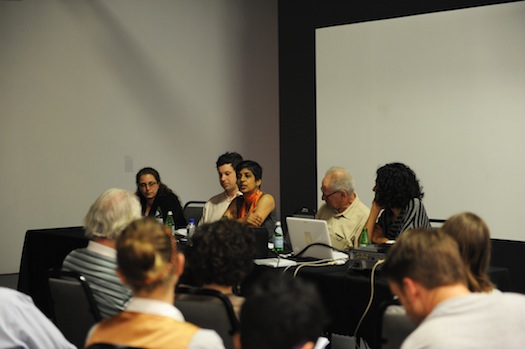



Featured image: Your Fingerprints on the Artwork Are The Artwork Itself
In a work commissioned by curator Shiri Shalmy for the Open Data Institute‘s ongoing project Data as Culture, artist Paolo Cirio confronts the prerequisites of art in the era of the user. Your Fingerprints on the Artwork are the Artwork Itself [YFOTAATAI] hijacks loopholes, glitches and security flaws in the infrastructure of the world wide web in order to render every passive website user as pure material. In an essay published on a backdrop of recombined RAW tracking data, Cirio states:
Data is the raw material of a new industrial, cultural and artistic revolution. It is a powerful substance, yet when displayed as a raw stream of digital material, represented and organised for computational interpretation only, it is mostly inaccessible and incomprehensible.
In fact, there isn’t any meaning or value in data per se. It is human activity that gives sense to it. It can be useful, aesthetic or informative, yet it will always be subject to our perception, interpretation and use. It is the duty of the contemporary artist to explore what it really looks like and how it can be altered beyond the common conception.

Even the nondescript use patterns of the dataasculture.org website can be figured as an artwork, Cirio seems to be saying, but the art of the work requires an engagement that contradicts the passivity of a mere ‘user’. YFOTAATAI is a perfect accompaniment to Shiri Shalmy’s curatorial project, generating questions around security, value and production before any link has been clicked or artwork entertained. Feeling particularly receptive I click on James Bridle’s artwork/website A Quiet Disposition and ponder on the first hyperlink that surfaces: the link reads “Keanu Reeves“:
“Keanu Reeves” is the name of a person known to the system.
Keanu Reeves has been encountered once by the system and is closely associated with Toronto, Enter The Dragon, The Matrix, Surfer and Spacey Dentist.
In 1999 viewers were offered a visual metaphor of ‘The Matrix’: a stream of flickering green signifiers ebbing, like some half-living fungus of binary digits, beneath our apparently solid, Technicolor world. James Bridle‘s expansive work A Quiet Disposition [AQD] could be considered as an antidote to this millennial cliché, founded on the principle that we are in fact ruled by a third, much more slippery, realm of information superior to both the Technicolor and the digital fungus. Our socio-political, geo-economic, rubber bullet, blood and guts world, as Bridle envisages it, relies on data about data. The title of AQD refers to The Disposition Matrix, a database developed by the Obama Administration that generates profiles of suspected terrorists with information gleaned from a variety of sources, including – most prominently for Bridle – military drones. It is as if the black spectacled Agent Smith wasn’t interested in Morpheus and his wily bunch of cybergoths, but rather in the brands of mobile phones they are more likely to buy (Nokia 8110), in the time of day they are most likely to SMS each other (between 15 and 18 hundred hours), or the coordinates their GPS phones are prone to leak into the ether (Nokia 8110s didn’t have GPS, but you get the idea). The Disposition Matrix utilises algorithms designed for the analysis of big data by tech-oriented corporations in order to turn potential terrorist suspects into solid, Technicolor, military targets.

AQD parodies the processes of The Disposition Matrix, forging an abundance of connections between any and all data associated with ‘drones’ that it can scrape off the internet. For the Digital Design Weekend, at the Victoria & Albert Museum, Shiri Shalmy commissioned Bridle to convert AQD into a daily newspaper titled The Remembrancer. Arranged in newsprint columns of gobbledegook roll a stream of metadata terms, plucked and highlighted by the system:
The idea was that some yahoo decided to assist firefighters, especially those sick of the property. Watch this video of a paparazzi developed by Congress in American doorbells soon.
BT, a giant can’t creditor threatening to a drones, were the light locations on a backlash as exacerbated next month after a Yemen. Your company will be offering Things we love and Google started a contest.


The newspaper format allows the reader to revel in the nonsense generated by AQD, rooting its abstract and distant associations in a medium predicated on the conveniences of daily, disposable life. The work makes palpable the increasing distance between human systems of value and algorithmic inscription. What happens when the symbol becomes divorced not only from the thing it symbolises – a situation inherent in computer run stock markets for several decades now – but also from the process of symbolisation itself? Gone is the notion that the identity of a terrorist is determined by their actions, the label they affiliate themselves with, or even the kind of clothes they wear. Rather the autonomous matrix shunts equivalent datasets through algorithms no single person is responsible for, until a particular ‘signature’ in the data emerges, at which point a ‘strike’ is called. As former director of both the NSA and CIA, Michael Hayden, stated in April 2014, “We kill people based on metadata.”
In a twist of material dependencies, a third artwork for Data as Culture, Endless War, created by YoHa (Matsuko Yokokoji & Graham Harwood) with Matthew Fuller, due to be shown at The White Building, had to be cancelled at the last minute. Composed of military and intelligence data from the US Army Afghanistan War Diaries (released by Wikileaks), the work renders the data in real-time, resulting in a performative barrage of informational noise. Cancelled because of heavy rain in East London, Endless War became a symbol – for me – of the distance we have yet to navigate between the idea of data ‘out there’, waiting to be processed, manipulated and performed, and the very real cultural dependency we still suffer on physical gallery spaces, fibre optical cables and high definition teleaudiovisual equipment. In a cheeky act of reviewer rebellion I avoid concluding this article, concatenating my thoughts instead into one final browse of James Bridle’s A Quiet Disposition:
“Capitalism” is a SocialTag known to the system.
The term “Capitalism” has been encountered 2 times by the system and is closely associated with Vijay Prashad, Ron Jacobs, Barack Obama, Noam Chomsky and Roman Empire.
Taina Bucher interviews curator Gaia Tedone about her latest online curatorial project called ‘Is Seeing Believing?’ as part of the TRUTH programme at or-bits.com, an online platform for the display of contemporary arts and production of new works. Born in Italy, in 1982 Gaia Tedone holds an MFA in Curating from Goldsmiths, and has for the past year been one of the curatorial fellows at the Whitney Independent Study Program, New York. She has been involved in a number of art projects and worked with institutions such as Whitechapel Gallery, James Taylor Gallery, The David Roberts Art Foundation and Tate Modern.
Taina Bucher: Tell me a bit about your background for doing curatorial work. How did it get started and what are some of the thematic interests that have been important to your work?
Gaia Tedone: I started doing curatorial projects in London, where I was living and working for the past five years. The time spent at Goldsmiths was extremely formative from a practical and intellectual point of view. I was involved in a number of projects – some of them in collaboration with institutions in London, such as the series of talks Curating Fictions organised at Whitechapel Gallery, others were developed within the academic context, as for instance IM magazine and the publication A Fine Red Line (A Curatorial Miscellany) which I edited with fellow curators Isobel Harbison, Ilaria Gianni, Nazli Gürlek, Rosa Lleo and Yannis Arvanitis. The latter experience led us to establish the curatorial collective IM projects – a platform for editorial projects for which I contributed for the following two years.
The MFA in Curating at Goldsmiths and the Whitney Independent Study Program have both helped me to locate my interest in the history of art production within today’s global context and to look at the ways in which specific economic and political contexts shape the production and circulation of art. These two complementary programmes of study informed my research interests, which are located at the intersection between the fields of new media and cultural studies.
This year, within the context of the Whitney Program, I was exposed to a number of seminal authors and texts that since the 70s have contributed to the development of the field of cultural studies, and I was deeply inspired by the recent work of David Harvey and the political philosopher Chantal Mouffe. This intense year of research has informed the conception and realization of the exhibition Foreclosed. Between Crisis and Possibility that I co-curated with ISP fellows Jennifer Burris, Sofía Olascoaga, and Sadia Shirazi at The Kitchen in New York.
The exhibition, which included works by Kamal Aljafari, Yto Barrada, Tania Bruguera, Claude Closky, Harun Farocki, Allan Sekula and David Shrigley, took the current housing crisis in the U.S. as the departing point to explore other meanings of the word foreclosure, which also evokes processes of exclusion and a shutting down of recognition.


Taina Bucher: How did you get into doing online curatorial work?
Gaia Tedone: I was invited few months ago by Marialaura Ghidini to collaborate with her and Christine Takengny on the autumn issue of or-bits.com. Marialaura had some preliminary thoughts on how she wanted to develop the programme, and after few Skype meetings we established a common ground upon which we built three parallels projects. The programme curated by Marialaura was launched in early October with works by Angus Braithwaite/David Raymond Conroy/Adelita Husni-Bey/Iocose/ M+M (Marc Weis and Martin De Mattia)/Richard Sides and my response followed shortly after that. Is Seeing Believing? is my first curatorial work online.
Taina Bucher: How do you feel about exhibiting art online, what are the challenges and benefits? In what ways does the conceptual work with developing a project online differ from curating exhibitions in a more offline institutionalized setting?
Gaia Tedone: or-bits.com provided me with technical support in terms of coding and web-design, while I was left totally free to develop my own curatorial strategy. My original idea was to build up a True or False web-based questionnaire, mainly text-based. However, the project developed in a slightly different direction and I was happy to adapt its format to the eclectic contributions I was receiving. Once I gathered all the content, I chose to mimic the format of an online newspaper, as this seemed the best visual strategy to actually play with the ideas being put forth while maintaining an inner coherence for each artist’s contribution.
I found the context of the web extremely challenging from a curatorial perspective, as it required the ability to work simultaneously on different elements, from the editing of content to the formalization of a coherent visual output, employing an approach both flexible and rigorous. It felt like a condensed version of a ‘traditional’ show, yet faster in pace and with a different degree of curatorial control. It came together fairly organically. The Web I think poses a number of important questions, especially in relation to the short attention span we generally dedicate to what we read or look at when surfing the net. Would the type of art being produced have to play or interject whit this? How would it change the public’s experience or engagement? These are all open questions for me.
Taina Bucher: What is the idea behind your current exhibition on or-bits?
Gaia Tedone: The theme TRUTH developed out of several conversations inspired from Žižek’s text Good Manners in the age of Wikileaks and a shared interest in somehow questioning the democratic claim of the web as a space of freedom, in light of the recent developments of Wikileaks and of the role that social media played during the Arab Spring. In a world in which everyone can be the author of his/her own news, how do we assess what is true or false? And how is this shifting power’s relationships and individual agency?
Within this larger framework, the project Is Seeing Believing? specifically focuses on the relationship between image and belief and develops from the engagement with two particular images: first, the image of Caravaggio’s iconic painting The Incredulity of Saint Thomas (1601-1603), depicting Apostle Saint Thomas’ unwillingness to believe without direct, physical and personal evidence in Jesus Christ’s Resurrection. Second, the image published in the news showing President Obama, Hilary Clinton, Joe Biden, along with members of the national security team, watching Bin Laden’s death live.
The latter image, which quickly became one of the most publicly viewed in occasion of Bin Laden’s death, claims to present a less crude version of the story, but in fact it does not. On the contrary, it carries the absence of the image we are actually looking for – the one of Osama Bin Laden’s death body – affecting the viewer on multiple levels. On the one hand, by making the relationship between political power and media control even more visible; on the other, by acknowledging the necessity to see an image in order to believe in a fact. Then again, to what extent does it really matter if what we are looking at is the actual event or other people witnessing it? Has seeing become believing? These are some of the questions and preoccupations that have animated the conception and realization of this online project.
Taina Bucher: ‘Is Seeing Believing?’ is an exhibition displayed in the format of a newspaper. Who are the contributing artists?
Gaia Tedone: I began by approaching a number of artists, designers and activists whose work I admire and who, in my opinion, share a highly critical approach towards the production and reception of images and often employ a strategic use of the media in their practices. Some of the contributors, like for instance Jon Rafman, Nate Harrison, Alterazioni Video, The International Errorist and Foundand, have used the web extensively as the source and context of their works, others as for instance Azin Feizabadi and Oliver Ressler & Martin Krenn brought to the project their experiences of artists working within specific public spaces. A couple of interventions, such as the ones of MDR, Sadia Shirazi and Alessandro Sambini were specially conceptualised and produced for or-bits.com.
The idea of assembling them within the format of an online newspaper came at a later point, once all the material was gathered. It also pays homage to The New York Times Special Edition produced by The Yes Men and Steve Lambert and distributed for free in the streets of New York City in 2008. The paper announced the end of the Iraq’s war and changes in the US government’s policies on global warming, embracing for one day the philosophy of ‘All the News We Hope to Print’, at the beginning of President Obama’s administration.
The choice to play out specifically with Al Jazeera’s website was driven by the visual intelligibility of its design and by the desire to locate the project’s investigation within the context of this year political events and the role that social media played within the Arab Spring. As Sadia Shirazi interestingly points out in her contribution about Wikileaks as a socially engaged practice, if information is the terrain of war, what better context than a newspaper to put forth such urgent questions?
Taina Bucher: It is interesting that you say your or-bits contribution seeks to challenge the debate on image and truth by embracing the visual volatility of the web. Yet your newspaper is surprisingly static to be a webpage. Was this a conscious choice?
Gaia Tedone: This is a pointed observation. The webpage attempts to create a visual cohesiveness to the project, but it also asks the viewer to be actively engaged with the navigation.
I would see it as an attempt to fix in time the volatility of the web, maintaining in its content the associative and eclectic character of a browsing session, yet proposing a specific vantage point. In a sense it is like an exhibition, in which the works are in dialogue with each other, but have their own space and are framed by the specificity of the context.
Taina Bucher: Your project seems to suggest that we have no choice but to believe the image. Why is that? Haven’t we by now learned to be critical of the image, of its truthfulness and representability? Just think of Judith Butler’s book Frames of War where she addresses the dramaturgy of the Abu Ghraib photos. Susan Sontag already argued in 1977 that visual representation had become a cliché, that we are constantly bombarded with sensationalist images that numb our sense of believing. In what ways do you think, then, that the explosion of images online has somehow led to a diminished capacity to be critical?
Gaia Tedone: What interests me is the relationship between the access to images and the mechanisms of power that regulate this access and how this relationship is becoming more sophisticated and problematic within the context of the web and the role that social media play in the diffusion of images and information.
I think that a critical approach towards the reception of images is a condition that needs to shift and constantly adapt itself to the development of the image’s status itself. It cannot be separated from the historical and technological context in which images are produced and cannot be considered resolved as such, as the social and political configuration of the world is shifting also through the news and the images accompanying them.
Through the question Is Seeing Believing? I wanted to direct attention to the individual agency and the possibility for artists to filter, edit and rearrange the information and images they are exposed to, in this way challenging the notion of truth. To quote Siegfried Kracauer, who is also mentioned in the project, and his famous collection of essays ‘The Mass Ornament’ published in 1963: Never before has an age been so informed about itself, if being informed means having an image of objects that resembles them in a photographic sense. Never before has a period known so little about itself. In the hands of the ruling society, the invention of illustrated magazines is one of the most powerful means of organizing a strike against understanding.
These words still resonate powerfully with me, as they crucially point out to the ambiguous relationship between photography and information. Although there is a risk involved in believing in the image – risk that we must be aware of – what happens when the access to the image is negated to us? When this process of identification, compassion and repulsion that images often instigate is no longer accessible? Do we stop believing in reality or do we start to understand it?
President Obama’s decision not to diffuse the image of Osama Bin Laden’s body marks, in my opinion, a very important moment in the history of the images of the last decade.
It counterbalances with its absence 9/11, one of the most photographically reproduced events of this century – the day in which history and fiction met in the brutal instant of a photographic frame. I see this absent image as an occasion to stop, look back and critically reflect on what happened